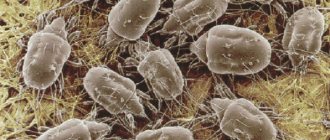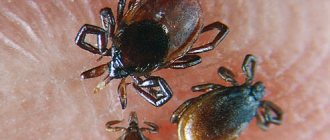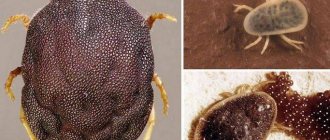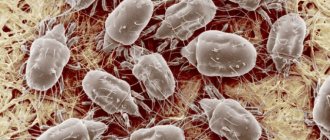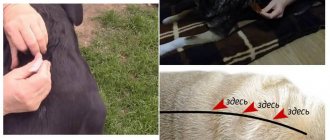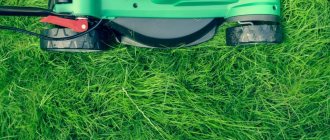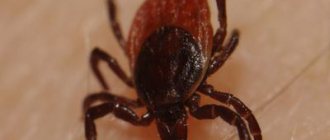Structural features
Ticks (Acari) belong to the class of arachnids, but due to their small size they are often classified as insects. The body length of different individuals ranges from 0.2 to 5 mm. Scientists have found more than 54 thousand species of representatives of the most significant group of arachnids in the world. Their body is whole or divided into two halves. The border is unclear, it is always shifted to the front. The main departments are called:
- Gnathosoma is a compact anterior part of the body with an oral apparatus, which is formed by the upper jaw - chelicerae and hypostome - a plate of fused limbs of the pedipalps.
- Idiosoma is an oblong body with walking limbs; it can be solid or segmented.
The outer covering of the body is called the cuticle. It has a different structure: a leathery chitinous cover, a hard shield or a durable shell. The outside of the body is covered with bristles, which are organs of touch. Ticks have 4 pairs of jointed legs. Due to their microscopic size, they cannot be seen without special magnification. The structure of the limbs is similar to that of insects; arachnids have 6 segments connected in series. They contain bristles, claws and suction cups. The number of limbs changes throughout life. The larva appears with three pairs of legs.
Information. The legs of parasitic mites are thick and short. They are covered with many strong suckers that help them attach to the owner.
The tick has from 1 to 5 eyes, which have a simple structure. Species living in the soil do not have visual organs. Breathing is carried out using special tubes - spiracles.
The structure of the oral apparatus
The mouthparts are located at the anterior end of the body. They are represented by the forelimbs - chelicerae and pedipalps. Ticks have two types of mouthparts:
- Piercing-sucking - this type is characterized by profound changes in the oral organs. The fused pedipalps became a hypostome and two stylets for piercing. Chelicerae form a proboscis, their outer surface is covered with teeth, facilitating reliable fixation on the host’s body. This type of mouthparts is found in ticks that feed on plant sap and the blood of animals or humans.
- Gnawing - the type is characteristic of arthropods that prefer solid food (seeds, flour, plant debris). They need to tear off pieces and crush pieces of food. The limbs of the chelicerae have turned into powerful claws designed for capturing food.
Gnawing-licking mouthparts
Characteristic of stinging hymenoptera that visit flowering plants to consume nectar. Examples: bees, bumblebees, wasps. Their upper jaws and upper lip are designed in the same way as in the gnawing mouthparts. They use their mandibles to capture prey (wasps) and dig nests in the ground (sand wasps), form pieces of wax (bees) or other materials to build their nests (paper wasps). The maxillae and lower lip have developed into a long retractable organ (usually called the ligule), which serves to penetrate deep into the flower and suck out nectar from there.
Classification of ticks
Scientists divide representatives of the Acarina group into 3 independent orders:
- Harvesters are large terrestrial inhabitants of the tropics.
- Acarimorphic mites are the most numerous group, numbering 30 thousand species. Among them there are pests of stocks and pathogens of human diseases. This order includes: barn mite, subcutaneous mite, scabies mite, and feather mite.
- Parasitomorphic mites are an order of arachnids, consisting of 12 thousand species. Among them there are predators, parasites and saprotrophs (destroyers of remains). The group includes the most dangerous pathogens of diseases in humans and animals: ixodid, gamasid, and argasid ticks.
Attention. Parasitomorphic mites have unique adaptive abilities; they have been evolving with their hosts for thousands of years.
Nutrition
The diet of arachnids is determined by their lifestyle. Herbivorous families (spider mites, gall mites) suck sap from leaves, stems or roots. This leads to slower growth, drying out and death of the crop. Agricultural pests are controlled using acaricidal drugs. Predators feed on eggs, insect larvae, or representatives of their own order. The Phytoseiidae species is used by gardeners to control phytophagous mites.
Saprophages living in the soil eat rotting plant debris, bacteria, spores, and algae. They contribute to soil recycling and humus formation. Some species of acarimorphic mites feed on food supplies. They settle in warehouses, mills, and barns. They eat flour, cereals, grains, seeds, dried fruits and nuts. Parasites feed on the blood, secretions of the sebaceous glands, hair or skin of the host. According to the method of parasitism, they are divided into two types: subcutaneous and cutaneous.
Attention. Adults can fast for two years without harm.
Variety of species
Among the most common types:
Ixodidae
Representatives of the order parasitize vertebrates (birds, mammals, reptiles). All of them are large in size - 3-30 mm; when fed with blood, the body increases in size. They live in all climate zones. The body is flat, oval in shape. They can parasitize on one, two or three hosts. In females, larvae and nymphs, the scutellum covers only a small part of the body. The rest of the surface is very elastic. During feeding, it stretches, allowing the size of the idiosome to increase several times. Males are designed differently; the dorsal shield covers the entire body. They cannot feed for 6-10 days like females. Hungry individuals are yellow, brown or black. After feeding they become gray or pinkish.
The ixodid tick parasitizes birds, mammals, and reptiles
Attention. The order includes carriers of the most dangerous diseases: tick-borne encephalitis, tularemia, typhoid, Q fever, Lyme disease.
The duration of the life cycle depends on the seasonality of feeding and reproduction. A fertilized female requires blood to develop her eggs. The laying is done in the forest floor. Autumn larvae overwinter hungry; in favorable conditions they require 1-4 weeks to develop. They feed on rodents. After molting, the larva turns into a nymph. It remains in this state throughout the warm season. In the absence of food, the tick nymph overwinters in this state. Its transformation into an adult is delayed until spring.
Blood-sucking activity occurs with the arrival of heat and humidity. The most dangerous periods for people are considered to be from May to July. Hungry adults and nymphs lie in wait in the grass and bushes. They are able to sense a person several meters away. To attach itself, the tick looks for a place with thin skin. They prefer the armpits, groin, neck, and behind the ear. Thanks to the introduction of an anesthetic substance into the wound, a person does not notice the puncture of the skin. Special protective equipment for walking and the use of acaricidal repellents will help prevent a bite.
Argasid mites
Representatives of this species parasitize poultry and animals. The body of arachnids has a dense leathery covering, their length is 3-30 mm. After saturation, the yellowish-brown color changes to purple. When a person is bitten, a severe allergy to the saliva of the tick occurs. Surprisingly, adults of this species can withstand an eleven-year hunger strike.
Barn mites
This group includes microscopic pests of grain, cereals, plant root systems, and cheese. Arthropods do not exceed 0.5-0.6 mm in size. Females lay eggs in food. After 4 days, hungry larvae emerge from them. After 5 days she turns into a nymph. Pests are resistant to high and low temperatures. They quickly spread with contaminated products. If it enters the respiratory tract, it causes asthmatic symptoms.
Dust mite
Synanthropic organisms live in every human home. A body 0.1-0.3 mm long cannot be seen without special devices. Their full life cycle is 60-70 days. Favorite habitat is bedding, pillows, mattresses. Parasite feces contain enzymes that cause severe allergies.
Oribatids or oribatid mites
Oribatids are the most numerous group of arthropods living in the soil. A characteristic feature of oribatid mites is their slow metabolism. They feed on plants, dead organic matter, mushrooms, and animal corpses. Their length is 0.7-0.9 mm, their habitat is forest litter, upper layers of soil.
Gamasid mites
This group includes 6 thousand species, among them there are parasitic and free-living families. Their representatives have a body size from 0.2 to 5 mm and are yellow or light brown in color. Among the most dangerous types: rat and mouse ticks. They are carriers of diseases. When bitten, it causes tick-borne dermatitis. The chicken parasite harms poultry farming, causing illness and even death of the livestock.
Demodex
A parasitic mite that lives in hair follicles. The length of its body is 0.3-0.4 mm. It feeds skin cells with fat. The body of the parasite is covered with scales, which help it to gain a foothold on the host. Moves along the surface of the skin. Most often affects older people (2/3 of cases).
Scabies itching
An intradermal parasite that causes scabies. The size of a male zudny is 0.23 mm, a female is 0.45 mm. The parasite gnaws holes in the host's skin. In them it reproduces and feeds on blood. Most often it affects the hands, armpits and groin.
Ticks of the family ixodidae (Murrey, 1877)
Morphology of ixodid ticks. More than 49 species of ixodid ticks have been registered in the CIS. All of them are temporary ectoparasites of vertebrate animals and carriers of pathogens of many diseases of mammals and birds: arboviruses, bacteria, blood parasites, rickettsia, etc.
Ixodid ticks are the largest; the size of females that have drunk the blood of animals can reach 20-30 mm. Segmentation of the body is not pronounced; the head, thorax and abdomen are fused into a continuous, undivided body, resembling a flattened sac, narrowed anteriorly. In the front part of the body there is a proboscis - the gnathosoma, followed by the idiosoma (the body itself). The proboscis, an organ of fixation, consists of a base, or collar, a dense chitinous plate of three-, four-, five- or hexagonal shape; pairs of upper jaws (chelicerae), which serve to cut the skin of the animal; hypostome (fused lower jaws), shaped like a harpoon, covered with teeth directed backwards for strong attachment to the host’s body; two four-segmented palps (palps), acting as organs of touch. At the base of the proboscis, females have a special sensitive organ - pore fields.
Adult ixodid ticks exhibit pronounced sexual dimorphism. On the dorsal side of the tick idiosome there is a scutum (scutum) - a thick, shiny chitinous formation. In males, the scutellum covers the entire dorsal side, while in females it covers only 1/3 of the idiosome behind the proboscis. This feature is the main difference between females and males. The color of the shield is often dark brown or gray. There are grooves on the scutum, the color, shape and number of which have diagnostic significance. The body color of drunken females varies greatly from steel-blue to light gray with a brownish or pinkish tint. The color of ticks that sucked lymph is always lighter than those that fed on blood.
In ticks of the genera Boophilus, Dermacentor, Rhipicephalus, Hyalomma, eyes are located on the sides of the shield, approximately at the level of the second pair of legs.
On the ventral side of the idiosome, the mite has a genital opening (at the level of the first–second coxa) and an anus (far behind the fourth pair of legs). In all genera (with the exception of Boophilus), an anal groove runs near the anus, going around it in front (only in Ixodes) or behind (in all other genera). Four pairs of jointed legs are attached to the idiosoma on the ventral side. Adults and nymphs have four, and larvae have three pairs of legs, consisting of five segments: a coxa (coxa), fixedly attached to the body, a trochanter, a thigh, a tibia, and a tarsus, which has a sucker at the end and two claws. The body (together with the scutum) and limbs are covered with a varying number of bristles, which, together with suction cups and claws, serve the mites for crawling and attaching to the animal’s cover and human clothing; The bristles serve as organs of touch. On the paws of 1 pair of legs there is an organ of smell - Haller.
The internal structure of ticks includes the digestive, respiratory, excretory, reproductive and nervous systems.
The digestive apparatus begins at the base of the hypostome with the oral opening, followed by the pharynx, which gradually passes into the esophagus, which flows into the central intestinal canal with long convoluted blind branches extending from it. The small intestine extends from the midgut, connecting, like the hind intestine, to the rectal bladder, where excretory products accumulate. The rectum opens with the anus, closed by a special valve. One female can suck 2-3 ml and stock up on a large amount of blood necessary for the formation of eggs. On the sides in the front of the body there are paired cluster-shaped salivary glands; The saliva produced during feeding is excreted through the salivary ducts through the mouth into the host's wound. Saliva has lysing properties, prevents the clotting of blood entering the intestines, and anesthetizes the bite.
The excretory apparatus consists of one pair of long, thin tubes (Malpighian vessels) winding throughout the body cavity. One end of them is blind, lies freely in the body cavity, the other flows into the rectal bladder.
The respiratory apparatus consists of a dense network of respiratory tubes - tracheas, extending from the common and cephalic trunks. A dense network of branched tracheas covers all parts of the body and opens outward along the edges of the body behind the fourth pair of legs with two spiracles (stigmas) located on special plates - peritremes (their shape is taken into account when identifying ticks).
The circulatory system is not closed. The blood of ticks (hemolymph) is colorless, washes all the organs of the body and enters the heart, which has the shape of a thickened sac. The aorta and trunks extend from the heart, supplying blood to the legs, proboscis and brain.
The nervous system is a single solid mass located in the front of the body on the ventral side. Many nerves extend from the brain to the limbs, eyes, mouth and internal organs.
The sense organs include the eyes (with the exception of the genus Ixodes and Haemaphysalis), a special organ of smell - Haller's organ, located on the paws of the first pair of limbs, as well as tactile bristles covering the body, proboscis, and limbs.
The female reproductive organs consist of the ovary, oviducts, uterus, spermatic receptacle, vagina, and a pair of accessory glands. In addition, there is a Zhene organ that produces a secretion that lubricates the eggs during laying. In males, the genital organs are represented by the testes, vas deferens and accessory glands.
The development cycle of ticks goes through transformations (metamorphoses): egg, larva, nymph and adult – sexually mature females and males. The female lays from 3-4 to 10 or more thousand eggs and dies (one gonotrophic cycle). After a certain period of time (1-2 weeks), depending on temperature and air humidity, the eggs hatch into six-legged larvae measuring 1.0 × 0.5 mm. Some time after the larvae emerge from the eggs, they become ready to attack animals and suck blood. The drunken larva increases in size and after 5-10 days molts into a nymph with four pairs of legs. The size of a hungry nymph is 2-3 mm. For subsequent development, the nymph must also drink blood, and then it turns into the adult phase - male or female. Ixodid ticks feed on the host's body a certain number of times over several days in each active phase. Depending on the type of food, one-, two- and three-host species are distinguished.
In single-host ticks (Boophilus calcaratus, Hyalomma scupense), the larva, nymph and mature individuals feed on the same animal on which they molt. Fertilization of females by males occurs in animals during the sucking period. Only well-fed, sexually mature ticks leave their host. The fallen females look for suitable places in crevices, under stones, under dead parts and roots of plants, under dry manure, etc., lay eggs and die.
In two-host ticks (some species of the genera Rhipicephalus, Hyalomma), development occurs on two hosts. Larvae and nymphs feed on the former. Here the larvae, without detaching, turn into nymphs on the spot, which, after feeding, fall off the host to the ground and turn into mature ticks. The latter attack the animal - the second owner, having fed, leave it to lay eggs on the ground.
In three-host ticks (genus Ixodes, Haemophysalis, Dermacentor, some species of the genera Hyalomma and Rhipicephalus), all three phases - larva, nymph and mature individuals - feed on three different animals, i.e., each phase leaves the host’s body after the end of blood-sucking. Larvae and nymphs feed on the blood of small mammals.
The lifespan of ticks varies. Larvae are capable of fasting from several months to a year, sexually mature individuals of some species - for several years. Hungry adults, drunken nymphs, and tick eggs overwinter in nature.
METHODS FOR COLLECTION AND STUDY OF IXODID TICKS
Methods for collecting ticks are divided into epizootic and regular, universal and selective, complete and partial. Epizootic collections are usually used to determine the degree of well-being of an area (farm) in relation to ticks; they are carried out both in natural and guest biotopes. Regular census collections and observations are carried out either continuously for a certain period of time, or at intervals of several minutes and hours, 5-10 days, and even up to several months. Collections can be general in case of a small number of animals and selective in case of a large number of animals. A harvest is called complete when all visible parasites are caught on animals. During partial collection, only an arbitrary number of parasites are counted and counted on a conventional scale designated: “very many”, “many”, indicating approximately the number for each designation.
The direct collection method involves partial or complete collection of ticks found on animals. When collecting from animals with short and straight hair, use a thin wooden plank (size 15-20 × 5 cm) with pointed long edges. It is carried out against the hair, looking at the skin behind the plate for the presence of ectoparasites.
A survey of the area for the presence of ticks is carried out in order to identify inhabited and uninhabited areas, the boundaries of these areas, species composition, the dynamics of the seasonal number of these arthropods in pastures, etc. (for this purpose, devices are used: a drag net, a flag, a towel, a screen, etc.) . The area can be examined using the method of route epizootic and regular tick counts in open nature, near livestock buildings, runs, watering places and resting places for animals. All received data is plotted in the form of symbols on a schematic map of the farm territory.
The best preservative liquid for ticks is 70% alcohol, 4-5% aqueous solution of formaldehyde. All ticks isolated from each count (from an animal, from pastures, etc.) are placed in a separate container, and the appropriate label is also placed there. During further processing, ticks are divided into genera and species, and then the number is calculated for 10 days or more. For greater clarity, the results obtained are depicted in the form of curves and diagrams.
When collecting ticks, you should reliably protect yourself from attacks by parasites. To protect your hands, you should use mesh handcuffs impregnated with a composition containing phthalate. The sleeves are made from a piece of mesh measuring 35x25 cm, trimming the edges with braid and sewing them in the form of a cylinder with a diameter of 18 cm. The sleeves are tied to the cuff of a tunic, shirt, etc.
DIFFERENTIAL DIAGNOSTICS OF TICKS OF THE FAMILY IXODIDAE
1. GENUS BOOPHILUS , Curtice, 1891. Body length of hungry individuals is 15 mm. The color of the scutellum is from yellow-brown to light brown. The eyes are flat and lateral. The proboscis is short, its base is hexagonal. The palps are short and ribbed. Males have two pairs of scutes on the ventral side of the idiosome. In the CIS it is recorded in the forest-steppe of southern Ukraine, the North Caucasus, Kazakhstan, Central Asia and Transcaucasia. Biotopes include river valleys, damp meadow thickets, and livestock buildings. The feeders are large and small cattle and horses. Active period from spring to December.
Boophilus calcaratus, Birula, 1895 – single-host tick. It is a carrier of Piroplasma bigeminum, P. ovis, Babesia colchica, brucellosis, Q fever.
2. GENUS HYALOMMA , Koch, 1844. Ticks are the largest in the family. IXODIDAE. The proboscis is long, its base is rectangular, the coxae of the first pair of legs are deeply split. Males have 2-4 pairs of scutes on the ventral side. The peritrema is occipital or retrovidous. The legs are powerful and long. Their biotopes are steppe, desert and semi-desert landscapes; some species live in shrubs, open forests, lowland and mountain forests, and in livestock buildings. They are carriers of pathogens of piroplasmosis, possibly tick-borne typhus, hemorrhagic fever, human Q fever, plague, leptospirosis and animal brucellosis. From this genus, farm animals are parasitized by the species H. anatolicum, H. detritum, H. plumbeum, and H. scupense.
H. Anatolicum, Koch, 1844, Found in floodplain meadows, fallow lands, livestock buildings near the nests of synanthropic birds in Central Asia, Kazakhstan, Transcaucasia and the Northern Caucasus. The hosts are cattle, horses, sheep, etc. The tick is a three-host tick. Adults are found on animals in April-May-June; larvae - in July-August, nymphs - in autumn and winter; parasites have one generation per year. The tick is a carrier of Theileria annulata, Th. mutans.
H. Detritum, Schulze, 1919, carrier of Theileria annulata, Th. mutans. The northern border of its range runs through Transcaucasia, Southern Kazakhstan, and throughout Central Asia. The tick has two hosts: larvae and nymphs parasitize one host, and adults parasitize another host. Active in May-September, all agricultural animals can be feeders. One generation develops per year.
H. Plumbeum, Koch, 1844, is found in intermountain valleys, deciduous forests, forb fallows, stacks and haystacks in the south of Ukraine, in Transcaucasia and Central Asia, in the south of Kazakhstan. The hosts are large and small domestic and wild mammals (imago) and brown hare, wild and domestic birds, mouse-like rodents (larva and nymph). The tick has two hosts and feeds on animals from July to October. It is carried by Piroplasma caballi, Nuttallia equi.
H. Scupense, Schulze, 1918, is a single-host tick. The northern border of the range passes in Ukraine, in the Kursk and Saratov regions, the Lower Volga region, and Central Kazakhstan. To the south, ticks are found everywhere in mixed-grass floodplain meadows. They parasitize animals during the cold season (October-May). Vector by Theileria annulata, Nuttallia equi.
3. GENUS DERMACENTOR , Koch, 1844. Characteristic of all species is the presence of silver-white (light enamel) spots on a dark background of the dorsal shield (marble pattern), limbs and proboscis. The proboscis is short, the palps protrude beyond the rectangular base of the proboscis. The eyes are flat and marginal. Males without ventral scutes. All species develop according to the three-host type. Ticks have one generation per year, the imago lives up to two years. They live in forests, steppes, and semi-deserts; in mountainous areas at an altitude of more than 2000 m above sea level they are carriers of pathogens of piroplasmosis, tick-borne encephalitis, tick-borne rickettsiosis, plague and tularemia.
D. marginatus, Sulzer, 1776 – carrier of Piroplasma caballi, Nuttallia equi, A. marginale, A. ovis, Th. recondita. Ticks are found in Ukraine, Moldova, Crimea, Voronezh region, the Middle and Lower Volga region, Kazakhstan, the North Caucasus, the southern part of Western and Eastern Siberia and Central Asia. Larvae and nymphs feed on mouse-like rodents, hedgehogs, water rats and other small animals. The adult parasitizes cattle, sheep, goats, and horses. The tick attack begins in May (mainly by adults); in the summer, mature ticks are not found; in the fall, the greatest increase in the number of ticks in animals is observed.
D. Pictus, Hermann, 1804 – carries P. caballi, N. equi, P. canis, A. marginale, equine encephalomyelitis virus, Omsk hemorrhagic fever virus. The distribution area is from the western borders to Eastern Siberia. Its biotopes are confined to the forest zone and meadow forest formations. The adult attacks animals at the end of March – April – May. Larvae and nymphs feed on hedgehogs, hares, and mouse-like rodents.
4. GENUS RHIPICEPHALUS , Koch, 1844 – relatively small ticks (hungry 2-5 mm, drunk females 10-15 mm), reddish-brown in color. The eyes are flat, marginal, and inconspicuous. The proboscis is short in the form of a truncated cone, its base is hexagonal. The palps are short, the coxae of the first pair of legs are deeply split, the anal groove goes around the anus from behind. Males have two pairs of ventral scutes.
Rh. Bursa, Canestrini Et Fanzago, 1877 – carrier of B. ovis, P. ovis, A. ovis, Th. recondite, A. marginale. Distribution area: Crimea, Krasnodar Territory, North Ossetia, Transcaucasia, Turkmenistan. Tick biotopes include virgin pastures and pastures with sparse shrubs. The tick has two hosts. In the adult phase, it parasitizes cattle and small cattle in March-July, the larvae attack in the second half of summer and autumn, the nymph parasitizes animals during winter. There is one generation per year.
5. GENUS HAEMAPHYSALIS , Koch, 1844 - mites with a short proboscis having a quadrangular base; palps are wide. The dorsal shield is brownish-brown or dark brown without a marbled pattern. There are no eyes. The anal groove goes around the anus in a closed semicircle from behind. Males without anal scutes; females without lateral grooves. Three-host mites. They transmit pathogens of piroplasmosis, brucellosis, tularemia and a number of rickettsial and viral diseases of animals, human plague. The following species are of greatest veterinary importance:
H. Otophila, Schulze, 1915 – carrier of A. ovis, P. ovis. It lives mainly in the arid steppes of the plains and foothills of Ukraine, the Krasnodar and Stavropol territories, Chechnya, Ingushetia, Dagestan, Transcaucasia, and Turkmenistan. The adult parasitizes small cattle and cattle in October-March. Larvae and nymphs feed on hedgehogs, hares, and steppe birds.
H. Japonica, Nuttall et Warburton, 1915 – carrier of Th. sergenti. It lives in the Far East in coniferous-deciduous forests. The concentration of ticks increases along river valleys and at the junctions of landscapes. The adult parasitizes animals in the first half of summer; larvae and nymphs feed on cattle, sika deer, etc. All phases of development attack animals.
6. GENUS IXODES , Latreille, 1795 – long-proboscis mites. The base of the proboscis is quadrangular in shape. The chitinous cover of the female is of various shades - from gray to red-pink-brown. There are no eyes or scallops. The anal groove (unlike other genera) goes around the anus in front in a closed semicircle. The first pair of cokes is not split. All species develop according to the three-host type.
I. Ricinus, Linnaeus, 1758 and I. Persulcatus, Schulze, 1930 are carriers of B. ovis, B. caucasica, A. ovis, A. marginale, pathogens of human viral and bacterial infections. Distributed in the European part of our country, with the exception of treeless steppe zones in the south, Murmansk and Arkhangelsk regions in the north, and the species' range in the east is limited by the Volga River. In the foothills and mountains of the Caucasus, ticks are often found in areas dominated by forests and shrubs.
Adults parasitize cattle, small cattle, horses, wild mammals and birds. Larvae and nymphs feed on all types of small mammals and birds. The life cycle of ticks in the north takes 3-4 years, in the North Caucasus - within one year.
THE FIGHT OF IXODID TICKS is carried out by destroying them in biotopes and on animals.
Destruction of ticks in biotopes is the most effective method. In most species of ticks, egg laying, larval hatching, and molting developmental phases occur on the ground (in natural pastures). Therefore, plowing and creating pastures with seeded grass can dramatically reduce the number of ticks, while the composition of vegetation, temperature and soil moisture change, which prevents the development of ticks. Sometimes changing pastures gives satisfactory results.
An important place in the fight against ixodid ticks is their destruction in biotopes - in livestock buildings by sealing cracks, rodent burrows, and destroying vegetation around farms. Then the room is treated with a 1% suspension or emulsion of sevin or dicresyl at a rate of 200-400 ml/m2. Before placing the animals (3-4 hours before), the room is ventilated, then the feeders are washed with hot water and the remaining drugs are removed. If ticks are found on animals, they are treated with acaricides.
Animal processing methods. Six main methods are used: bathing in floating baths, spraying, dusting, watering along the spine, applying acaricides to the coat in the form of a paste, injections and oral use of acaricides. The first two methods are acceptable only in the warm season, the rest - in both warm and cold periods. Sheep are usually bathed (see tables 1 and 2) .
Spraying is carried out on specially equipped sites - MDU, with automatic supply of acaricides, or on fenced concrete sites, using spray equipment: LSD, DUK, VDM, etc. Working fluid is used for small livestock - 1.5 liters, for cattle and horses – 2-4l, for camels – 5-10l per animal. Acaricides contained in aerosol and propellant cans are also used for spraying. The treatment is carried out from a distance of 20-30 cm, pressing on the head of the aerosol can or actively working with the lever of the propellant can.
Preparations for irrigation - purons are applied to the skin of the animal along the spine; When processing sheep, the fleece is first spread apart. In regions where vaccination or mitigating chemoprophylaxis is used, animals are treated once every 15-20 days, and with pencils or Butox - after 25-40 days, depending on the residual effect of the drug. In the cool season, it is advisable to use dust, pencils, aerosols, and acaricide injections.
Animals are treated with acaricides before ixodid ticks attack them, for which they use drugs that act simultaneously on larvae, nymphs and adults. The effectiveness of the drugs is determined by the absence of newly attached larvae, nymphs, and adults by the time of the next treatment. Acaricides can cause toxicosis in animals, so anti-tick treatments are not recommended for young animals up to 3 months of age and for pregnant animals one month before giving birth. To avoid toxicosis, animals are processed in the cool part of the day.
When using acaricides, it is very important to calculate the dose and concentration of the drug according to the active substance (AI) in working emulsions and solutions. When calculating, use the following formula:
X=AxB
C
Where X is the amount of technical preparation (emulsifying concentrate) required to prepare the working solution, kg; A is the amount of solution that needs to be prepared for processing, l; B is the concentration of acaricide according to the DV, which must be obtained in the working solution; C-content of DV in the original preparation in %.
Calculation example: from 20% emulsifying concentrate (e.c.) propoxur for spraying 250 heads of cattle, it is necessary to prepare 0.5 x 250 = 125 l of emulsion of 0.4% concentration. Using the formula we get: X=(125x0.4)/20=2.5. Therefore, to prepare 125 liters of 0.4% propoxur emulsion, you need to take 2.5 kg of 20% e. to this drug.
In addition, traps have been developed to catch imagoes and nymphs of ixodid ticks on the host’s body. The trap is disc-shaped and contains ferromone and acaricide. The trap is attached to the tail. Acaricidal collars and bags with the acaricide amitraz or cyhalothrin, which are attached to the tail of the animal, are also proposed. The effectiveness of the bags reaches 87-93% and remains at this level for 90-94 days.
